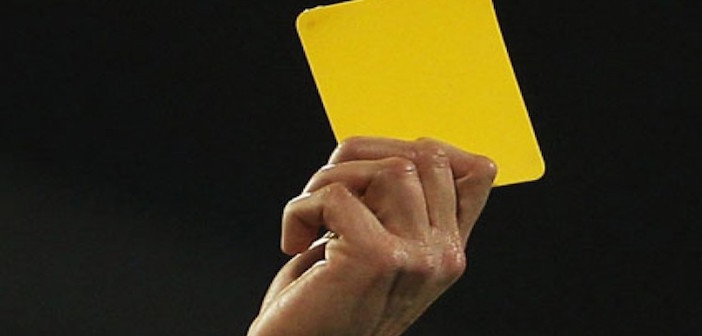CARDS and referees specialist Chris Goodwin (@CGeorgeGamble) delivers his guide to the teams and officials to follow in 2020/21, as well as sharing some of his best advice for finding bookings value ahead of the new season.
WLB Season Preview 2020/21 | A guide to the cards market
The new football season is going to be underway extremely soon and so I’ve put together a preview of my top referees and teams to follow, both from the UK and in Europe, in terms of cards.
It’s always a difficult task to predict which teams are going to have poor disciplinary records, however, the statistics can help to give you a good idea.
Firstly, let’s go to the UK. The Premier League and EFL is returning and I’ve got my eye on a few teams who I think will tally up a high number of Booking Points over the course of the campaign.
Top 5 UK teams to watch for cards
1) Barnsley
The Tykes avoided relegation on the final day of last season after beating promotion-chasing Brentford 2-1 at Oakwell. Over the course of last season, Barnsley had the second-worst disciplinary record in the Championship, collecting a massive 94 yellows and averaging just over two cards per-game.
I think they may struggle in the second-tier again this term and considering the Reds committed the fifth-most fouls per-game last term, I fancy them to be right up there in terms of cards received.
2) Tottenham
Jose Mourinho’s men underperformed last season and will have to play a second-round qualifier to make it into the Europa League. In 2019/20, Spurs had the second-worst disciplinary record in the Premier League and collected 82 yellow cards. Tottenham tended to be hardworking and like to break up opposition play, with tactical fouls often being the way to do it.
Spurs have signed Pierre Hojbjerg, who committed the second-most fouls for Southampton last season, and will add a little bit more bite in the team's midfield, so I’d expect their games to see a decent number of cards on a consistent basis.
3) Watford
Watford were abysmal last season and it was no surprise to see the Hornets drop down into the Championship. They received 76 yellows and committed more fouls on average per-game than any other side in the Premier League. In fact, they’ve been the most ill-disciplined side in two of the last five campaigns and have been in the top-three for cards in four of the last five renewals.
It’s obviously difficult to assess if this will continue whilst they’re playing in the second-tier, but Watford's last season in the Championship saw the Hornets receive the second-highest number of cards. I’ll be keeping an eye on their first few games to see what style they play – if it’s still aggressive with a high foul count, they may be a consistent play for cards.
4) Aston Villa
Aston Villa's return to the Premier League could’ve gone better and they were still exceptionally lucky to stay up. Had it not been for goal-line technology having a funny five minutes, the Second City club would have surely been down and out. Nevertheless, they’re preparing for another season in the top-flight.
It’s looking more and more likely that talisman Jack Grealish will be plying his trade at Villa Park next season and that is a massive boost. Grealish was the most fouled player in the Premier League last season and challenges on him were followed by a huge number of yellow cards.
The trend seemed to be that whenever Villa played, there were cards. Whether it be for fouls on the aforementioned Grealish, or the Villans themselves who were fighting for their lives and committing infringements in dangerous areas.
At the time of writing, Matty Cash is the only signing Dean Smith’s side have made and it’s not a statement signing per-se. He’s a good player who’s extremely versatile, but is he a player that will massively improve the Claret & Blue and push them up the table?
I personally believe Villa are going to be embroiled in yet another relegation battle, as such, I expect their games (referee depending) to see a high amount of cards awarded.
5) Southampton
I was extremely impressed with Ralph Hasenhüttl’s side in the second half of the season. Southampton looked solid and as though they were one of the better sides in the league.
I do feel that occasionally, referees were somewhat lenient towards Saints last season in a number of games I watched. The south coast club committed the fourth-most fouls in the league yet were nowhere near the top-six most ill-disciplined sides in terms of cards received.
James Ward-Prowse has signed a new contract, which is excellent news. He committed the fifth-most fouls in the division last term playing in the heart of the Saints midfield and with Pierre Hojbjerg now gone, he’ll need to step up again.
Depending on who Hasenhüttl bring in, I expect Southampton to be absolutely fine and finish around mid-table, but I also think refs might get wise to the persistent fouling. As such, don’t be surprised to see Saints pick up some cards on a consistent basis in the upcoming season.
Top 5 UK referees to watch for cards
1) Peter Bankes
Peter Bankes awarded 55 yellows last season in just 11 games that he officiated. Combined with the 2018/19 season, he has awarded 185 cations in just 40 appearances, which give us an average of 4.63 cards per-game over the past two campaigns.
Sides who received the most cards per-game on average last season when Bankes was referee:
- Nottingham Forest – 4.00 cards per-game
- QPR – 3.50 cards per-game
- Norwich – 3.00 cards per-game
2) David Coote
David Coote awarded 38 yellows in eight appearances last season. Combined with the 2018/19 season, he has awarded 66 yellows in 15 Championship outings, handing out an average of 4.40 cards per-game over the past two campaigns.
Sides who received the most cards per game on average last season when Coote was referee:
- Sheffield Wednesday – 4.00 cards per-game
- QPR – 4.00 cards per-game
- Millwall – 3.00 cards per-game
3) Stuart Attwell
Stuart Attwell dished out a massive 88 yellow cards in just 11 Premier League appearances last season, meaning he had the highest average cards shown per-game total (5.00 per-game).
Over the past two seasons, Attwell has handed out 103 yellows in 24 games – an average of 4.29 cards per-game.
Sides who received the most cards per game on average last season when Attwell was referee:
- Tottenham – 3.50 cards per-game
- Everton – 3.50 cards per-game
- Arsenal – 2.75 cards per-game
4) Mike Dean
If you follow the cards market then this is probably the man you know all about. Mike Dean is synonymous with cards and that’s reflected in his statistics.
Last season, the Tranmere fanatic handed out 112 yellows in just 27 games – an average of 4.15 cards per-game. The past two terms combined sees his total at 241 cards in 56 matches, an average of 4.30 cards.
Sides who received the most cards per game on average last season when Dean was referee:
- Sheffield United – 3.00 cards per-game
- Chelsea – 3.00 cards per-game
- Tottenham – 2.67 cards per-game
5) Anthony Taylor
Anthony Taylor is another referee who is probably the most well known for handing out cards. However, he appeared to be a bit more lenient in the Premier League towards the latter stages of last season, unlike in Europe where we saw him almost run out of ink due to writing so many players into his book.
Last season, Taylor brandished a total of 122 yellows in 32 appearances (3.81 per-game). Over the two terms, he has shown 224 yellows in 64 games (3.50 per-game).
Sides who received the most cards per game on average last season when Taylor was referee:
- Chelsea – 3.25 cards per-game
- Tottenham – 3.00 cards per-game
- Norwich – 3.00 cards per-game
Top 5 European teams to watch for cards
1) Getafe
There are three things certain in life: death, taxes and a Getafe yellow card. The Spaniards were the most ill-disciplined side throughout Europe’s top leagues last season, collecting a colossal 131 yellow cards in just 38 La Liga games – an average of 3.45 cards per-game!
Los Azulones committed the most fouls per-game in La Liga by some margin, an average of 18.6 per-game. They have an extremely aggressive style of play and they’ll want to build on the outstanding season they’ve just had, meaning they might even fight a little harder.
From a card betting perspective, I can’t wait to see them get back underway.
2) Leganes
We’ve just mentioned how bad Getafe are at keeping things clean, well Leganes aren’t too much better. Europe's second-highest card collectors last term have now been relegated to the Segunda and will fancy their chances of bouncing back.
I felt for Leganes during last season – Barcelona signed Martin Braithwaite, their first-choice striker, after being granted permission to make an emergency signing by La Liga, yet when Leganes asked for a similar deal to replace him, they were refused. Politics, eh!
Despite, playing in the Spanish second-tier, they will still pick up a lot of cards as that’s how they play, with aggression and breaking up play at the earliest opportunity. I’ll be keeping close attention to their first few games to see if they start right where they left off.
3) Cagliari
One of the best teams for cards, Cagliari, had the second-worst discipline record in Serie A last season and it’s a common theme. In the four campaigns played since their most recent promotion to the top-flight, the Isolani have been in the top five most ill-disciplined teams in all.
The Sardinians don’t tend to commit as many fouls as the other most booked sides, but when they do foul, they’re more often than not always worthy of a card.
4) Bologna
Serie A’s most carded side – Bologna – settled for a mid-table finish last term and will want to build upon that and aim for Europe. After watching them a lot last season, the main reason for the lack of discipline is individual errors and defending counter-attacks. No side had more unsuccessful touches last season and this led to panic defending, and in turn, desperate fouls committed.
With Bologna's aim being to push higher in the table, I’d expect this trend to continue, particularly in games where luck may not be going their way.
5) Koln
I, as I’m sure many did, got to learn a lot more about the Bundesliga as it was the first big league to return after the lockdown was partially lifted.
From a cards viewpoint, Koln were one of my favourite teams to back simply because of the way they played and the situations they’d find themselves in. They were the third-most booked side in the Bundesliga.
Striker, Jhon Cordoba is somewhat of an enigma. He was the fourth-most fouled player in the league last term but he also committed the fifth-most fouls and was Koln’s third-most booked player. He loves to get stuck in and make a nuisance of himself but that can sometimes be costly.
The Billy Goats managed to avoid relegation but as of yet, they’ve made no significant signings to improve their team. I think they may struggle this season and will have to deal with a lot of pressure, so I’ll be keeping a close eye on their disciplinary stats this season.
Top 5 European referees to watch
1) Xavier Estrada
He’s essentially the Spanish Mike Dean.
Estrada is, without doubt, the most card-happy referee in Europe. Last season he dished out 132 yellows in just 20 appearances in La Liga – 6.60 cards on average per-game. The past two seasons combined has seen him brandish 255 yellow cards in 41 appearances – 6.22 cards per-game. To have those numbers over the course of two terms is quite simply ridiculous.
Sides who received the most cards per game on average last season when Estrada was referee:
- Eibar – 6.00 cards per-game
- Celta Vigo – 6.00 cards per-game
- Getafe – 4.00 cards per-game
2) Pablo Gonzalez Fuertes
Another referee to keep an eye out for when La Liga resumes, Pablo Gonzalez Fuertes is a referee who is not lenient in the slightest. No referee awarded more free-kicks on average than Fuertes (32.00 per-game) and he has some impressive figures to go along with that.
Last season he gave 110 yellow cards in 19 league appearances – 5.79 cards per-game. Over the past two seasons, he has given out 196 yellow cards in 38 appearances – 5.16 cards on average.
Sides who received the most cards per game on average last season when Fuertes was referee:
- Valencia – 6.00 cards per-game
- Celta Vigo – 4.00 cards per-game
- Osasuna – 4.00 cards per-game
3) Marco Guida
If you’re betting on cards then keep an eye on Marco Guida when he’s officiating. Last season in Serie A he handed out 12 reds in just the 17 games. In those matches, he also awarded a total of 17 penalties.
In terms of cards, his stats are still exceptional. Last season he dished out 91 yellow cards – an average of 5.59 per-game. Over the past two campaigns, he has shown 180 yellow cards in 33 Serie A appearances – an average of 5.45 cards per-game.
Sides who received the most cards per game on average last season when Guida was referee:
- Milan – 4.50 cards per-game
- Bologna – 4.00 cards per-game
- Sampdoria – 4.00 cards per-game
4) Daniele Orsato
Another referee that you should definitely have in your shortlist for cards is Daniele Orsato. He has a decent average in Serie A but the elite competitions are where this number shoots up.
In Serie A last season, he showed 91 yellow cards in 17 appearances – an average of 5.35 cards per-game. Across the past two terms, he has brandished 195 yellows in 36 outings – an average of 5.42 per-game.
But in last season's Champions League, Orsato officiated just six games but dished out a ridiculous 41 yellow cards – an average of 6.83 cards per-game. Keep a close eye on him in the elite competitions in 2020/21.
Sides who received the most cards per game on average last season when Orsato was referee:
- Bologna – 5.00 cards per-game
- Fiorentina – 4.33 cards per-game
- AC Milan – 4.00 cards per-game
5) Sascha Stegemann
Although he wasn’t the most card-happy ref in the Bundesliga last season, I feel that Sacha Stegemann is one of the most consistent for cards as he has been one of the top four refs for bookings in the last two terms in Germany.
He handed out 67 yellows in 15 appearances last season – 4.47 cards per-game on average. And in the last two terms combined, he has shown 125 yellows in 29 appearances – 4.31 cards per-game.
Sides who received the most cards per game on average last season when Stegemann was referee:
- Mainz – 4.00 cards per-game
- RB Leipzig – 3.50 cards per-game
- Borussia Monchengladbach – 3.50 cards per-game
What to look for when trying to find a card-based bet?
1) Refer to the statistics
I will always refer to my spreadsheet table with all of the statistics and focus on teams that I can immediately draw from memory that see quite a few cards.
Once I’ve found a particular game that I like, let’s say for example, Getafe versus Valencia. Getafe are playing at home and I can see they commit a high number of fouls in their games whilst Valencia are also one of the most-fouled teams in La Liga. Combining those with the referee who has one of the highest cards per-game stats is key.
Having consulted the statistics, I will possibly look to favour Getafe seeing a card in the first-half and three or more Getafe cards overall. I will then look at Getafe’s fixtures against teams of a similar ilk – Valencia are a top-half side so I will look at all of Getafe’s fixtures so far that season against the top-half teams to see how many times my chosen bet has landed previously.
2) Getting your information and probability
Value is absolutely vital if you want to ensure making long-term profit. To find the value we need to look at our statistics and get an edge on the implied probability (odds) given by the bookies.
To keep it simple, let’s say that we’ve looked and Getafe have played 10 other games at home to teams in the top-half, and my bet of a Getafe first-half card and three or more Getafe cards overall has landed in seven of those 10. That tells us it has landed 70% of the time this season in similar fixtures.
3) Securing the value
We know that this bet has landed 70% of the time, now we want to find the best price for this bet. Let’s say Bet365 are offering odds of 6/5 for our bet. This represents an implied probability of 45.5%.
The bookies are suggesting the likelihood of this bet landing is just 45.5%, yet it has landed in 70% of similar games? With those differences, I would be having a play purely based on the difference between the implied probability offered by the bookies and our own statistical knowledge.
Of course, variance plays a huge role and you can’t be right all the time, however, you can always put yourself in a position to take advantage of these differences!
For regularly updated statistical spreadsheets follow me at @CGeorgeGamble.








